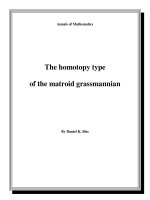bamboo growing. the giant grass
Bạn đang xem bản rút gọn của tài liệu. Xem và tải ngay bản đầy đủ của tài liệu tại đây (393.25 KB, 4 trang )
About Bamboo, the Giant Grass
Bamboo forest ecosystem. A dense, evergreen bamboo forest is a peaceful and
magical place. As the wind bends the flexible bamboo, the poles clack and the leaves
whisper. Bamboo has inspired human beings for millenia.
The fastest growing plant. Bamboo is not a tree, it is a giant grass. Some species
grow four feet in one day! Bamboo reaches full height in one growth spurt of about two
months. When bamboo is harvested, the root system is unharmed and healthy, ready to
produce more shoots, just like a grass lawn.
1500 varieties. Bamboo grows naturally in the
tropical world extending to temperate climates.
Running bamboo spreads underground and pops up
like a weed. Clumping bamboo is preferred because it
remains in the area it is planted. 5000 uses. For
thousands of years, bamboo has benefited people in
Asia, Africa, South America: building materials with the
strength of steel, furniture, weapons (first rocket was a
bamboo tube stuffed with gunpowder), writing and
musical instruments, fuel, food, medical products.
Bamboo for building. Some grows so large it is called timber bamboo- 120 feet high
and 13" diameter. Thick bamboo poles are 2-3 times stronger than comparable size of
wood timber. Bamboo can be harvested in 7 years versus 10-50 years for softwoods and
hardwoods, yielding up to 20 times more than wood. One bamboo clump can produce
200 poles in the five years it takes one tree to reach maturity. Bamboo can be
sustainably harvested and replenished with virtually no impact to the environment.
Grow your own home. It's a renewable resource for housing, flooring, paneling, fencing
and more. In the tropics, it's possible to grow your own home. In Costa Rica, 1000
bamboo houses have been built annually from a 60 hectare (150 acre) plantation.
Download 4 page brochure about Growing Bamboo. PDF file size 400 k.
1
061115
Bamboo's Role in Environmental Restoration
Our biosphere is suffering from resource depletion, habitat loss, species extinction and
ecosystem pollution, suggesting sustainability is not enough. Architects and developers
can now choose materials and systems that have a restorative effect on the
environment. Bamboo can play a key role.
Bamboo is the fastest growing plant. It produces greater biomass and 30% more
oxygen than a hardwood forest on the same area, while improving watersheds,
preventing erosion, restoring soil, providing sweet edible shoots and removing toxins
from contaminated soil. Bamboo produces structural beams, flooring, wall paneling,
fencing and many more sustainable by-products of environmental restoration.
Bamboo timber can be harvested every year after 7 years, compared to 30 to 50
years for trees. With 10-30% annual increase in biomass versus 2-5% for trees, bamboo
can yield 20 times more timber than trees on the same area. Bamboo can be selectively
harvested annually and regenerates without replanting.
Bamboo generates 30% more oxygen than trees. It helps reduce carbon dioxide
gases blamed for global warming. Some bamboo sequesters up to 12 tons of carbon
dioxide per hectare, which makes it an efficient replenisher of fresh air.
Bamboo is a natural water control barrier. Because of its wide spread root system
and large canopy, bamboo greatly reduces rain run off, prevents massive soil erosion
and keeps twice as much water in the watershed. Bamboo helps mitigate water pollution
due to its high nitrogen consumption, making it a solution for excess nutrient uptake of
waste water from manufacturing, livestock farming and sewage treatment.
Bamboo can restore degraded lands. It is a pioneering plant and can be grown in soil
damaged by overgrazing and poor agriculture. Proper harvesting does not kill the
bamboo plant, so topsoil is held in place. Because of its dense litter on the forest floor it
feeds topsoil, restoring healthy agricultural lands for generations to come.
Bamboo Living | Homes | Resorts | Owners | Movies | Bamboo | Environment | Vietnam | Factory | Assembly | Research | Links
2
061115
Growing and Harvesting Bamboo in Vietnam
Vietnam has an estimated 200,000 square
miles of bamboo forests.
After Vietnam was defoliated by Agent Orange in
the American War, bamboo was the first species to
begin regenerating the forests.
Today, villagers in 29 provinces grow bamboo for
domestic and export products.
An important bamboo for construction timber
is bambusa stenostachya, or "tre gai", a clumping
bamboo. Much of the tre gai bamboo comes from
villages in Central Vietnam.
The tops of tre gai bamboo are used by chopstick
factories, and the long, thick bottom poles usually
ended up as scrap. Now Bamboo Technologies
uses these sturdy, hard poles (10-14' long, 3"-4"
diameter) to build houses.
Bamboo growth cycle
New bamboo clumps
mature enough to grow full
size poles in about three
years. In one three month
spurt bamboo shoots reach
full diameter and height,
more than 60 feet high. In
three years poles mature
into dense, hard bamboo.
Harvesting bamboo at
maturity is the critical first
step to insure strong and
durable quality poles. When
bamboo poles reach peak
strength and hardness,
villagers in Central Vietnam
harvest them. Bamboo
clumps will grow new
shoots for as many as 75
years.
Next >> Harvesting Bamboo in Central Vietnam
Bamboo Living | Homes | Resorts | Owners | Movies | Bamboo | Environment | Vietnam | Factory | Assembly | Research | Links
3
061115
Growing Bamboo in Maui
A promising new agricultural enterprise. Hawaii's sugar cane and pineapple
industries are contracting, and the state is searching for new crops. Bamboo is an
environmentally sound replacement to help preserve Hawaii's agricultural heritage.
Bamboo research centers and plantations are sprouting up in the Hawaiian Islands,
especially on Oahu, Kauai and the Big Island. Already popular for fencing, flooring and
furniture, now there is growing demand for bamboo timber for houses. To read more
about this trend, see
Honolulu Magazine "Bamboo Boom?"
Whispering Winds Bamboo Farm (www.whisperingwindsbamboo.com) in Kipahulu, Maui,
is part of a tropical hardwood reforestation project. The greenhouse, shadehouse and
nursery propagate over 50 species of bamboo, including ornamental, timber and edible
bamboo. Growers research which ones grow best in various ecological conditions.
The plantation has five acres, about 600 plants, interplanted with nitrogen fixing trees.
Twenty acres are projected by the end of 2005. Products are nursery stock, edible
shoots, ornamental bamboo and timber bamboo poles.
Bamboo Living | Homes | Resorts | Owners | Movies | Bamboo | Environment | Vietnam | Factory | Assembly | Research | Links
4
061115









